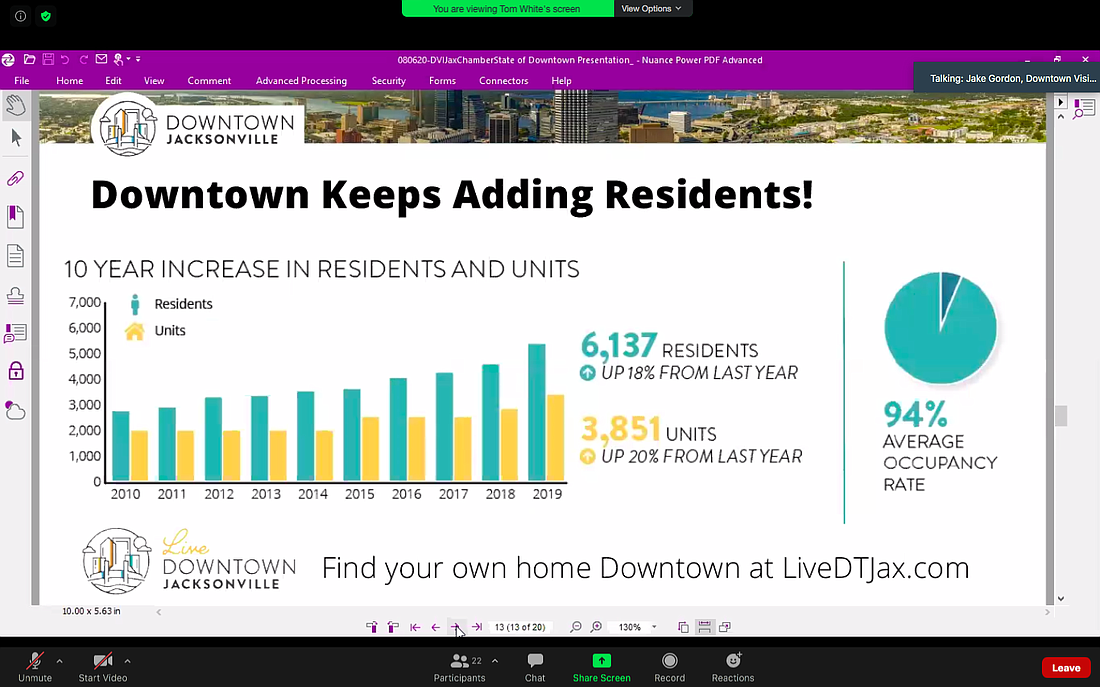
Downtown Jacksonville added more than 1,100 residents and about 770 apartment units since January 2019, according to Downtown Vision Inc.’s annual report.
DVI CEO Jake Gordon and Downtown Investment Authority CEO Lori Boyer previewed the data Aug. 6 during a JAX Chamber ImpactJAX Public Policy Committee virtual State of the Downtown forum.
Gordon said the full report will be released Aug. 10.
The data collected over 18 months ending in June found 6,137 residents living in Downtown’s Northbank and Southbank, up 18% from last year.
The number of residential units Downtown was 3,851, a 20% increase. DVI says those units have an average 94% occupancy rate.
Boyer said residential growth could temporarily slow because of the COVID-19 pandemic, but she predicts Downtown still will reach the DIA’s goal of 10,000 residents by 2024.
“I believe that we may have a year delay in the middle here where things have slowed down, but we were on a trajectory where we would have easily been at 10,000 residents in the next three years. So maybe it’s four years,” Boyer said.
DVI worked with real estate firm CBRE to compile data on residential and office vacancies.
Office space outlook
Gordon said Downtown’s 4.2 million square feet of Class A office space has a 14.6% vacancy rate. DVI and CBRE expect Class A vacancy to be below 14% when final second-quarter 2020 data is available.
In an interview after the forum, Gordon said Downtown hasn’t seen the full impact of the pandemic on office vacancy.
Gordon said the healthy Downtown office cores in the U.S. have an average 10% vacancy rate. He characterized the report as positive compared to the nearly 25% average vacancy rate Downtown in 2011 during the last economic recession.
“This is very low for us,” Gordon said. “From a real estate perspective, it’s hard to put that into context, it doesn’t seem like a lot. But it’s like baseball. If you’re batting .300 or you’re batting .500, those are gigantic differences.”
The DVI report shows Downtown’s 2.62 million square feet of Class B office inventory had a 14% vacancy rate, and the vacancy rate for the 634,819 square feet of Class C office space is 15.3%.
The pandemic’s long-term impact on commercial office space is unclear, with more companies moving toward remote working for many employees to promote social distancing.
Boyer and Gordon differ in their outlooks for the commercial office market.
“I would say that I have been a little more reserved … and concerned about some of the corporate entities Downtown that are talking about long-term work-from-home arrangements and how that will affect our office vacancy eventually,” Boyer said.
Boyer said markets like New York City are seeing an exodus from corporate office cores like Manhattan to the suburbs, but Jacksonville’s lower Downtown density will be more appealing to smaller office development projects.
“In many of the developments I’m seeing now people are talking about a seven-story building being preferable to a 30-story building,” Boyer said. “What we’ve got going for us is our land cost and availability still facilitates seven-story buildings. So we can attract those kinds of people who want to do mid-rises and think the mid-rise is more the market of the future than the high-rise,” she said.
Gordon sees commercial office space rebounding after the pandemic subsides.
“It’s kind of like people thought we’d all have flying cars and the newspaper would go away. I’m not totally sure offices are going to go away right away,” Gordon said. “I’m personally desperate to get out of my house myself.”
The State of the Downtown report shows $530 million in Downtown development projects completed in the 18-month period.
DVI said $2.9 billion in projects are under construction and there is $3.1 billion in proposed projects. DVI’s 2018-19 State of the Downtown report showed $215 million in Downtown investment.
Boyer pointed to Fidelity National Information Services Inc.’s $145 million world headquarters in Brooklyn, which began site work in May, and JEA’s proposed $62.9 million, 162,000-square-foot corporate office building at 337 W. Adams St. as examples of projects moving forward.
Foot traffic and retail
In the short term, Gordon said the pandemic has had a severe impact on Downtown retail business. Foot traffic from daily visitors decreased as much as 62% during the pandemic, according to DVI.
DVI partnered with Regency Centers Corp. to use cellphone activity data Downtown to calculate the drop. Gordon said companies use similar software to track foot traffic in shopping centers.
The report said that from March 14 through July 31, Downtown had 21,641 daily average visitors.
Before Mayor Lenny Curry issued his COVID-19 emergency declaration March 13, Downtown had 56,199 daily visitors on average. Gordon said the data did not count people who work Downtown.
The DIA is seeing demand for retail incentive programs in 2020, like its Food and Beverage Retail Enhancement Program.
Since June, the DIA board has approved incentives for Ruby Beach Brewing Co. at 228 E. Forsyth St. and The Bread & Board restaurant at 100 W. Bay St.
Boyer said more applications for the program are being filed. She credits a continued interest in the development programs to construction timelines that will put new restaurants in a position to open in mid-2021, possibly after COVID-19 transmission subsides.
“Everybody needs to realize, it takes a year to build-out one of these facilities,” Boyer said. “By the time you finish with the project, the demand will be back.”